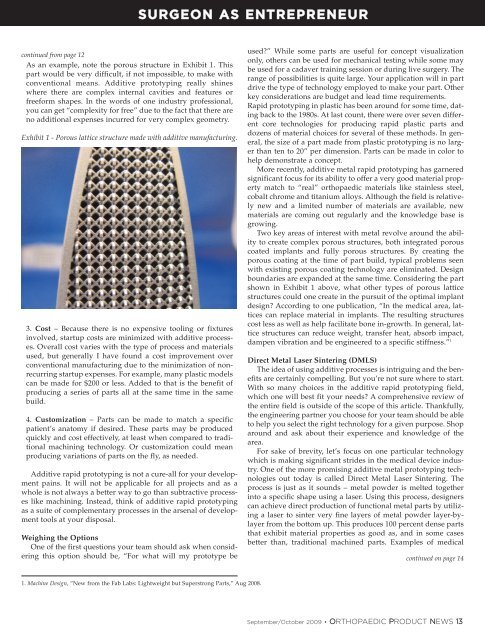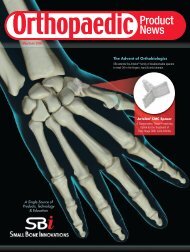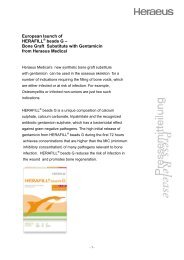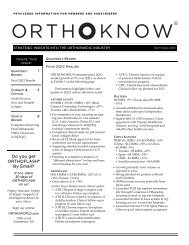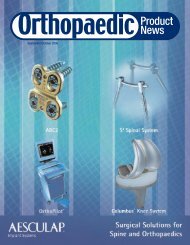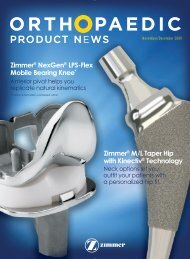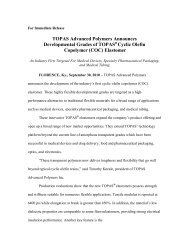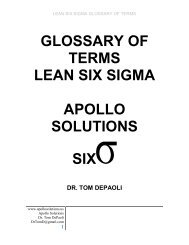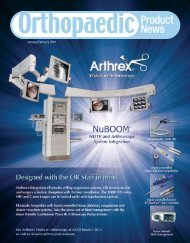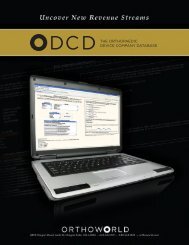Spinal Surgery, Cement Systems - Orthoworld
Spinal Surgery, Cement Systems - Orthoworld
Spinal Surgery, Cement Systems - Orthoworld
Create successful ePaper yourself
Turn your PDF publications into a flip-book with our unique Google optimized e-Paper software.
SURGEON AS ENTREPRENEUR<br />
continued from page 12<br />
As an example, note the porous structure in Exhibit 1. This<br />
part would be very difficult, if not impossible, to make with<br />
conventional means. Additive prototyping really shines<br />
where there are complex internal cavities and features or<br />
freeform shapes. In the words of one industry professional,<br />
you can get “complexity for free” due to the fact that there are<br />
no additional expenses incurred for very complex geometry.<br />
Exhibit 1 - Porous lattice structure made with additive manufacturing.<br />
3. Cost – Because there is no expensive tooling or fixtures<br />
involved, startup costs are minimized with additive processes.<br />
Overall cost varies with the type of process and materials<br />
used, but generally I have found a cost improvement over<br />
conventional manufacturing due to the minimization of nonrecurring<br />
startup expenses. For example, many plastic models<br />
can be made for $200 or less. Added to that is the benefit of<br />
producing a series of parts all at the same time in the same<br />
build.<br />
4. Customization – Parts can be made to match a specific<br />
patient’s anatomy if desired. These parts may be produced<br />
quickly and cost effectively, at least when compared to traditional<br />
machining technology. Or customization could mean<br />
producing variations of parts on the fly, as needed.<br />
Additive rapid prototyping is not a cure-all for your development<br />
pains. It will not be applicable for all projects and as a<br />
whole is not always a better way to go than subtractive processes<br />
like machining. Instead, think of additive rapid prototyping<br />
as a suite of complementary processes in the arsenal of development<br />
tools at your disposal.<br />
Weighing the Options<br />
One of the first questions your team should ask when considering<br />
this option should be, “For what will my prototype be<br />
used?” While some parts are useful for concept visualization<br />
only, others can be used for mechanical testing while some may<br />
be used for a cadaver training session or during live surgery. The<br />
range of possibilities is quite large. Your application will in part<br />
drive the type of technology employed to make your part. Other<br />
key considerations are budget and lead time requirements.<br />
Rapid prototyping in plastic has been around for some time, dating<br />
back to the 1980s. At last count, there were over seven different<br />
core technologies for producing rapid plastic parts and<br />
dozens of material choices for several of these methods. In general,<br />
the size of a part made from plastic prototyping is no larger<br />
than ten to 20” per dimension. Parts can be made in color to<br />
help demonstrate a concept.<br />
More recently, additive metal rapid prototyping has garnered<br />
significant focus for its ability to offer a very good material property<br />
match to “real” orthopaedic materials like stainless steel,<br />
cobalt chrome and titanium alloys. Although the field is relatively<br />
new and a limited number of materials are available, new<br />
materials are coming out regularly and the knowledge base is<br />
growing.<br />
Two key areas of interest with metal revolve around the ability<br />
to create complex porous structures, both integrated porous<br />
coated implants and fully porous structures. By creating the<br />
porous coating at the time of part build, typical problems seen<br />
with existing porous coating technology are eliminated. Design<br />
boundaries are expanded at the same time. Considering the part<br />
shown in Exhibit 1 above, what other types of porous lattice<br />
structures could one create in the pursuit of the optimal implant<br />
design? According to one publication, “In the medical area, lattices<br />
can replace material in implants. The resulting structures<br />
cost less as well as help facilitate bone in-growth. In general, lattice<br />
structures can reduce weight, transfer heat, absorb impact,<br />
dampen vibration and be engineered to a specific stiffness.” 1<br />
Direct Metal Laser Sintering (DMLS)<br />
The idea of using additive processes is intriguing and the benefits<br />
are certainly compelling. But you’re not sure where to start.<br />
With so many choices in the additive rapid prototyping field,<br />
which one will best fit your needs? A comprehensive review of<br />
the entire field is outside of the scope of this article. Thankfully,<br />
the engineering partner you choose for your team should be able<br />
to help you select the right technology for a given purpose. Shop<br />
around and ask about their experience and knowledge of the<br />
area.<br />
For sake of brevity, let’s focus on one particular technology<br />
which is making significant strides in the medical device industry.<br />
One of the more promising additive metal prototyping technologies<br />
out today is called Direct Metal Laser Sintering. The<br />
process is just as it sounds – metal powder is melted together<br />
into a specific shape using a laser. Using this process, designers<br />
can achieve direct production of functional metal parts by utilizing<br />
a laser to sinter very fine layers of metal powder layer-bylayer<br />
from the bottom up. This produces 100 percent dense parts<br />
that exhibit material properties as good as, and in some cases<br />
better than, traditional machined parts. Examples of medical<br />
continued on page 14<br />
1. Machine Design, “New from the Fab Labs: Lightweight but Superstrong Parts,” Aug 2008.<br />
September/October 2009 • ORTHOPAEDIC PRODUCT NEWS 13


